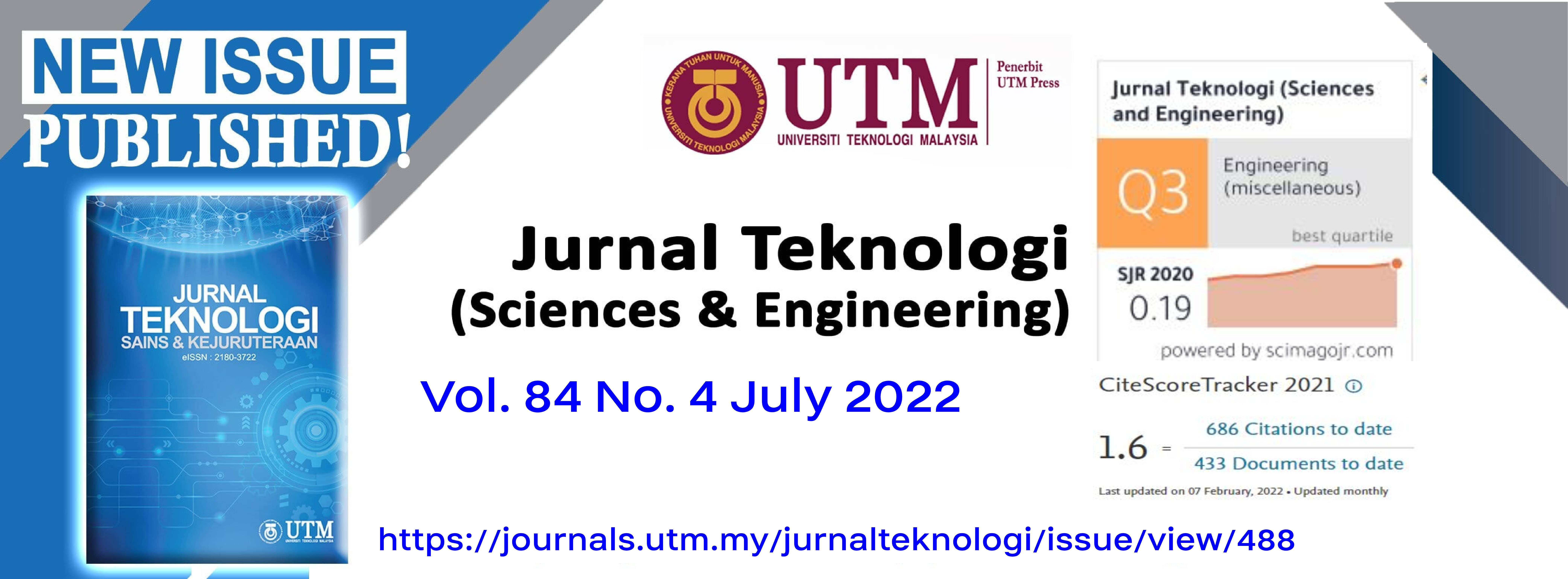IMPERIALIST COMPETITIVE ALGORITHM FOR INCREASING THE LIFETIME OF WIRELESS SENSOR NETWORK
DOI:
https://doi.org/10.11113/jurnalteknologi.v84.17685Keywords:
Wireless sensor networks, Imperialist competitive algorithm, Cluster head selection, network lifetime, energy efficientAbstract
Recent years have seen the rapid growth in the applications of wireless sensor network (WSN) which is due to the advances of sensor nodes with low cost and tiny size. Despite the various potential applications of WSN, one of the key tasks in sensor network design is to make sure that the network is functional as long as possible. This paper presents an energy-efficient cluster head selection algorithm for the clustering of heterogeneous WSN, inspired by Imperialist Competitive Algorithm (ICA). In order to reduce the network energy consumption and subsequently increases the sensor network lifetime, the clustering problem is transformed into an optimization problem and the specific cost function is used to select the cluster heads in a way that the energy utilization of the network is optimized. Extensive simulation works are done based on MATLAB to test the algorithm in various network scenarios, with different network sizes and number of nodes. Simulation results have shown that the proposed algorithm is able to extend the network lifetime compared to its comparative by up to 154 percent in terms of first node death. Furthermore, choosing the optimum set of cluster heads at every round has proved that our proposed algorithm not only could reduce the network energy consumption, but also improves the total data delivery at the base station up to 59 percent compared to the well-known algorithm.
References
Srbinovska, M., et al. 2015. Environmental Parameters Monitoring in Precision Agriculture Using Wireless Sensor Networks. Journal of Cleaner Production. 88: 297-307.
DOI: https://doi.org/10.1016/j.jclepro.2014.04.036
Ahmad, I., K. Shah, and S. Ullah. 2016. Military Applications Using Wireless Sensor Networks: A Survey. Int. J. Eng. Sci. 6(6): 7039. DOI: 10.4010/2016.1678.
Al-Dhief, F. T., et al. 2019. A Review of Forest Fire Surveillance Technologies: Mobile Ad-Hoc Network Routing Protocols Perspective. Journal of King Saud University-Computer and Information Sciences. 31(2): 135-146.
DOI: https://doi.org/10.1016/j.jksuci.2017.12.005.
Niroumand, Z. and Aghdasi, H. S. 2017. A Geographic Cross-layer Routing Adapted for Disaster Relief Operations In Wireless Sensor Networks. Computers & Electrical Engineering. 64(C): 395-406.
DOI: https://doi.org/10.1016/j.compeleceng.2017.07.021.
Lu, J., et al. 2019. Artificial Agent: The Fusion of Artificial Intelligence and a Mobile Agent for Energy-efficient Traffic Control in Wireless Sensor Networks. Future Generation Computer Systems. 95: 45-51.
DOI: https://doi.org/10.1016/j.future.2018.12.024.
Pirbhulal, S., et al. 2017. A Novel Secure IoT-Based Smart Home Automation System Using A Wireless Sensor Network. Sensors. 17(1): 69.
DOI: https://doi.org/10.3390/s17010069.
Shankar, A. and Jaisankar, N. 2016. A Novel Energy Efficient Clustering Mechanism In Wireless Sensor Network. Procedia Computer Science. 89: 134-141.
DOI: 10.1016/j.procs.2016.06.022.
Lin, D. and Wang, Q. 2019. An Energy-efficient Clustering Algorithm Combined Game Theory and Dual-Cluster-Head Mechanism for WSNs. IEEE Access. 7: 49894-49905.
DOI: 10.1109/ACCESS.2019.2911190.
Qureshi, K. N., et al. 2020. Optimized Cluster-based Dynamic Energy-aware Routing Protocol for Wireless Sensor Networks in Agriculture Precision. Journal of Sensors. 2020.
DOI: https://doi.org/10.1155/2020/9040395.
Jan, B., et al. 2017. Energy Efficient Hierarchical Clustering Approaches In Wireless Sensor Networks: A Survey. Wireless Communications and Mobile Computing. 2017.
DOI: https://doi.org/10.1155/2017/6457942.
Radhika, S. and Rangarajan, P. 2019. On Improving the Lifespan of Wireless Sensor Networks with Fuzzy Based Clustering and Machine Learning Based Data Reduction. Applied Soft Computing. 83: 105610.
DOI: https://doi.org/10.1016/j.asoc.2019.105610.
Heinzelman, W. B., Chandrakasan, A. P. and Balakrishnan, H. 2002. An Application-specific Protocol Architecture for Wireless Microsensor Networks. IEEE Transactions on Wireless Communications. 1(4): 660-670.
DOI: 10.1109/TWC.2002.804190.
Latiff, N. A., Tsimenidis, C. C. and Sharif, B. S. 2007. Energy-aware Clustering for Wireless Sensor Networks Using Particle Swarm Optimization. IEEE 18th International Symposium on Personal, Indoor and Mobile Radio Communications. 2007. 1-5. DOI: 10.1109/PIMRC.2007.4394521.
Jia, D., et al. 2015. Dynamic Cluster Head Selection Method for Wireless Sensor Network. IEEE Sensors Journal. 16(8): 2746-2754. DOI: 10.1109/JSEN.2015.2512322.
Latiff, N. A., Nik Abdul Malik, N. N. and Idoumghar, L. 2016. Hybrid Backtracking Search Optimization Algorithm and K-Means for Clustering in Wireless Sensor Networks. IEEE Intl Conf on Pervasive Intelligence and Computing. 2016: 558-564.
DOI:10.1109/DASC-PICom-DataCom CyberSciTec.2016.106.
Janakiraman, S. 2018. A Hybrid Ant Colony and Artificial Bee Colony Optimization Algorithm-based Cluster Head Selection for IoT. Procedia Computer Science. 143: 360-366.
DOI: https://doi.org/10.1016/j.procs. 2018.10.407.
Ahmad, M., et al. 2021. Optimal Clustering in Wireless Sensor Networks for the Internet of Things based on Memetic Algorithm: memeWSN. Wireless Communications and Mobile Computing. 2021(8875950): 1-14.
DOI: https://doi.org/10.1155/2021/8875950.
Tanwar, A., Sharma, A. K. & Pandey, R. V. S. 2020. Fractional-grasshopper Optimization Algorithm for the Sensor Activation Control in Wireless Sensor Networks. Wireless Personal Communication. 113: 399-422. DOI: 10.1007/s11277-020-07206-4.
Tay, M., Senturk, A. A. 2022. New Energy-aware Cluster Head Selection Algorithm for Wireless Sensor Networks. Wireless Personal Communication. 122: 2235-2251. DOI: 10.1007/s11277-021-08990-3.
Chaitra, H. and G. K., D. R. 2019. Energy Efficient Clustering Method for Wireless Sensor Network. Indonesian Journal of Electrical Engineering and Computer Science. 14(2): 1039-1048.
Dehestani, F. and Jamali, M. A. J. 2020. Load Balanced Clustering based on Imperialist Competitive Algorithm in Wireless Sensor Networks. Wireless Personal Communications. 1-15.
Atashpaz-Gargari, E. and Lucas, C. 2007. Imperialist Competitive Algorithm: An Algorithm for Optimization Inspired by Imperialistic Competition. IEEE Congress on Evolutionary Computation. 4661-4667.
DOI: 10.1109/CEC.2007.4425083.
Jubair, A. M., Hassan, R., Aman, A. H. M., Sallehudin, H., Al-Mekhlafi, Z. G., Mohammed, B. A., Alsaffar, M. S. 2021. Optimization of Clustering in Wireless Sensor Networks: Techniques and Protocols. Applied Sciences. 11: 11448. DOI: 10.3390/app112311448.
Downloads
Published
Issue
Section
License
Copyright of articles that appear in Jurnal Teknologi belongs exclusively to Penerbit Universiti Teknologi Malaysia (Penerbit UTM Press). This copyright covers the rights to reproduce the article, including reprints, electronic reproductions, or any other reproductions of similar nature.
















